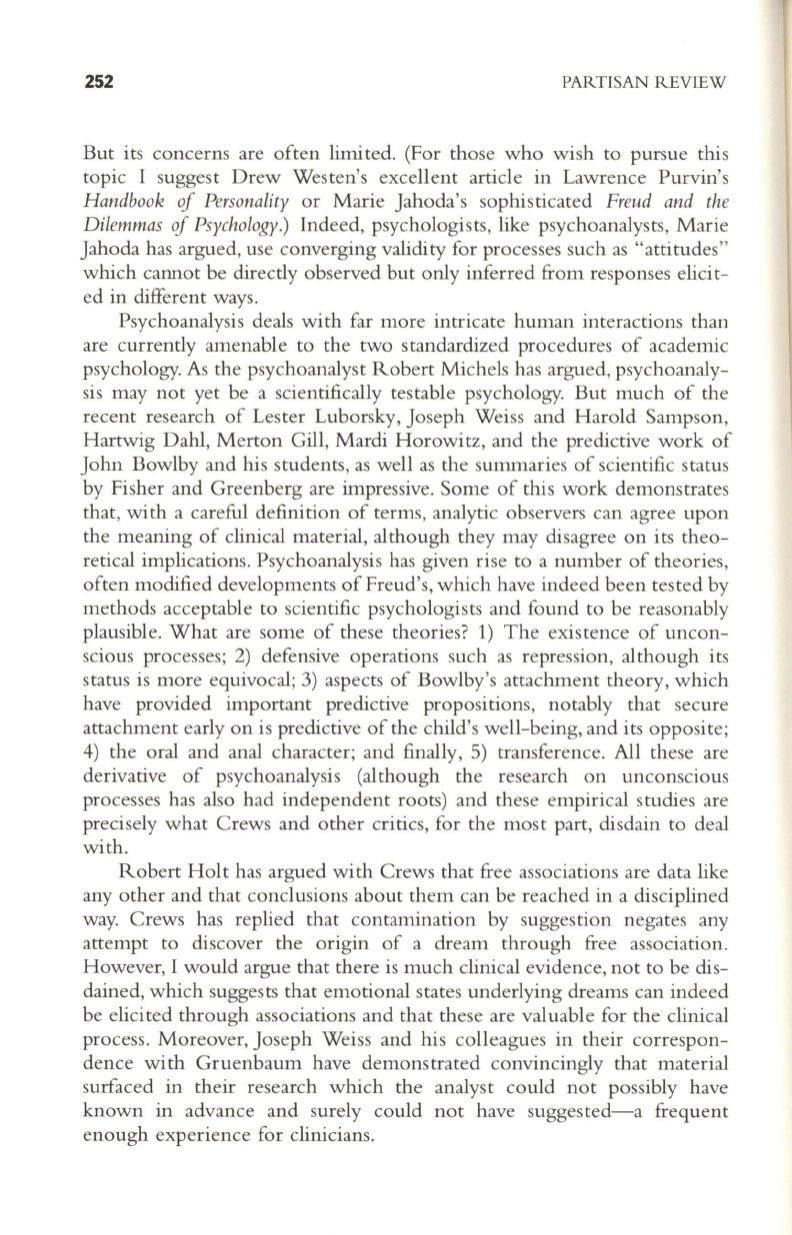
252
PARTISAN REVIEW
But its concerns are often limited. (For those who wish to pursue this
topic I suggest Drew Westen's excellent article in Lawrence Purvin's
Handbook
if
Personality
or Marie Jahoda's sophisticated
Freud and the
Dilemmas
if
Psychology.)
Indeed, psychologists, like psychoanalysts, Marie
Jahoda has argued, use converging validity for processes such as "attitudes"
which cannot be directly observed but only inferred from responses elicit–
ed in different ways.
Psychoanalysis deals with far more intricate human interactions than
are currently amenable to the two standardized procedures of academic
psychology. As the psychoanalyst Robert Michels has argued, psychoanaly–
sis may not yet be a scientifically testable psychology. But much of the
recent research of Lester Luborsky, Joseph Weiss and Harold Sampson,
Hartwig Dahl, Merton Gill, Mardi Horowitz, and the predictive work of
John Bowlby and his students, as well as the summaries of scientific status
by Fisher and Greenberg are impressive. Some of this work demonstrates
that, with a careful definition of terms, analytic observers can agree upon
the meaning of clinical material, although they may disagree on its theo–
retical implications. Psychoanalysis has given rise to a number of theories,
often modified developments of Freud's, which have indeed been tested by
methods acceptable to scientific psychologists and found to be reasonably
plausible. What are some of these theories? 1) The existence of uncon–
scious processes; 2) defensive operations such as repression, although its
status is more equivocal; 3) aspects of Bowlby's attachment theory, which
have provided important predictive propositions, notably that secure
attachment early on is predictive of the child's well-being, and its opposite;
4) the oral and anal character; and finally, 5) transference. All these are
derivative of psychoanalysis (although the research on unconscious
processes has also had independent roots) and these empirical studies are
precisely what Crews and other critics, for the most part, disdain to deal
with.
Robert Holt has argued with Crews that free associations are data like
any other and that conclusions about them can be reached in a disciplined
way. Crews has replied that contamination by suggestion negates any
attempt to discover the origin of a dream through free association.
However, I would argue that there is much clinical evidence, not to be dis–
dained, which suggests that emotional states underlying dreams can indeed
be elicited through associations and that these are valuable for the clinical
process. Moreover, Joseph Weiss and his colleagues in their correspon–
dence with Gruenbaum have demonstrated convincingly that material
surfaced in their research which the analyst could not possibly have
known in advance and surely could not have suggested-a frequent
enough experience for clinicians.


